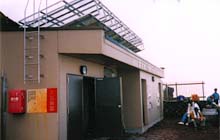 |
 |
 |
 |
 |
 |
|||||
 |
 |
 |
 |
|
NATURE CALLS: Human Waste Causes Problems on Mount Fuji September 17, 1999  One of the toilets on Mount Fuji now posing a smelly environmental problem. (Shin'nosuke Tabata) At 3,776 meters (12,388 feet), Mount Fuji is Japan's tallest and most sacred peak. Every year about 300,000 alpinists and tourists make the ascent to its summit. The mountain is situated in a national park, and the area above the fifth station--which marks the 2,300-meter (7,550-feet) line--is designated as a special protection zone, where the natural landscape is strictly preserved for posterity. In recent years, however, the disposal of human waste in this area has become a serious issue. Various efforts are underway to find a way out of this bind. Charged or Free Services? Since July 1999, therefore, the agency has been asking users to contribute about 100 yen (0.91 dollars) each time they use one of these toilets. The revenue will be allocated to management costs, but more important than this, the agency says, "We're hoping that this will encourage climbers to care about the mountain's environment." Many climbers express doubts about this scheme, however, arguing that regulating entry to the mountain is more important for environmental conservation, and that if the purpose is to raise people's awareness of environmental issues there must be better ways of doing so. Prior to this, the Environment Agency had already placed donation boxes in restrooms in the tourist areas of Kamikochi in Nagano Prefecture and the Oze marshlands in central Honshu. In Kamikochi, where there are also attendants on duty, the revenue totals 35 million yen (320,000 dollars) a year--although it should be noted that the number of visitors to Kamikochi comes to about two million a year, almost seven times that for Mount Fuji. The Japanese people have traditionally taken for granted that toilets can be used free of charge. Perhaps a change of attitude needs to take place before the custom of voluntary payment for toilets can take root in Japan. Various Efforts In another plan, "biotoilets" are being developed that would use microorganisms to decompose human waste on the spot. Experiments are now being conducted to see how well the microbes survive through a winter on the mountain and to test the power of certain microorganisms to reduce foul smells. Campaigns are also being carried out to promote awareness of the impact of human activity on the environment, one example being the distribution of water-soluble pocket tissues to visitors. Because regular tissues are insoluble, if tossed away they will accumulate and spoil the landscape; some processing facilities, moreover, will not accept waste matter containing them. In the final analysis, whatever solutions are thought up can succeed only with the cooperation of the climbers.  Edited
by Japan Echo Inc. based on domestic Japanese news sources. Articles presented
here are offered for reference purposes and do not necessarily represent
the policy or views of the Japanese Government. Edited
by Japan Echo Inc. based on domestic Japanese news sources. Articles presented
here are offered for reference purposes and do not necessarily represent
the policy or views of the Japanese Government.
|

